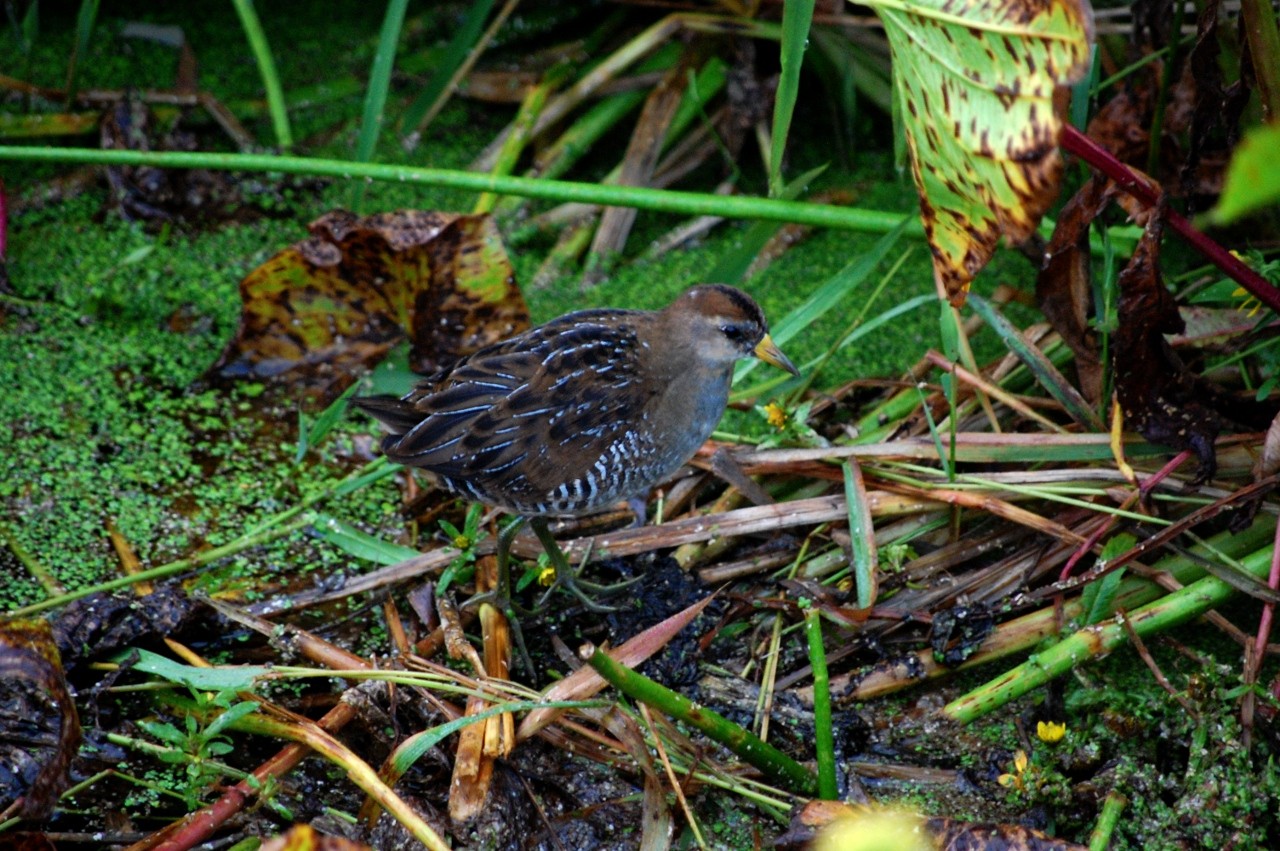Sora
A species of Large Gray Crakes, Also known as Chicken-billed Rail, Carolina Crake, Chicken-bill, Sora Rail, Soree Scientific name : Porzana carolina Genus : Large Gray Crakes
Sora, A species of Large Gray Crakes
Also known as:
Chicken-billed Rail, Carolina Crake, Chicken-bill, Sora Rail, Soree
Botanical name: Porzana carolina
Genus: Large Gray Crakes
 Photo By J Jongsma , used under CC-BY-SA-2.0 /Cropped and compressed from original
Photo By J Jongsma , used under CC-BY-SA-2.0 /Cropped and compressed from original Description
Adult soras are 19–30 cm (7.5–11.8 in) long, with dark-marked brown upperparts, a blue-grey face and underparts, and black and white barring on the flanks. They have a short thick yellow bill, with black markings on the face at the base of the bill and on the throat. Sexes are similar, but young soras lack the black facial markings and have a whitish face and buff breast. They weigh about 49–112 g (1.7–4.0 oz) and have a wingspan of 35–40 cm. 
Size
20-25 cm (8-10 in)
Colors
Brown
Black
Gray
Nest Placement
Floating
Feeding Habits
Sora predominantly consume wetland plant seeds, like sedge, bulrush, grasses, and smartweed, including wild or cultivated rice. They forage by raking vegetation with extended toes and peck across the water for seeds and aquatic bugs such as snails and various insects.
Habitat
Sora are typically found in marshy wetlands surrounded by dense vegetation such as cattails, sedges, and rushes. They prefer shallow to intermediate water depths, thriving in both freshwater and brackish environments, including seasonal or semipermanent wetlands, wetland edges, and occasionally in brackish or salt marshes along coastal regions. During migration and winter, their habitat can extend to wet pastures, ditches, impoundments, and flooded fields, even amidst upland fields and row crops adjacent to wetlands.
Nest Behavior
Sora females begin laying eggs upon completing the nest foundation, continually adding materials during the laying process. Males assist by supplying vegetation. The female camouflages the nest by weaving overhead vegetation into the structure for concealment.
Nest Characteristics
Sora nests are located at the edges of shallow wetlands in dense cattail and sedge patches. The nests are shallow baskets, woven from cattails and sedges, about 6 inches wide, either on vegetation mounds or attached to stems, with cover fashioned from surrounding plants.
Dite type
Granivorous
People often ask
Migration Overview
Sora's northern migration occurs in spring, primarily in April and May. For instance, in east-central Kansas significantly (p<0.05) more soras were detected from 24 April to 7 May than the 2-week periods before or after. In southeast Missouri, soras were observed from 25 March to 6 May. Soras were first detected in April to early May in Colorado, Iowa, and Minnesota. In a summary of the first detections of soras in Minnesota, Manitoba, and Saskatchewan, all occurred in April. Soras depart their breeding grounds as early as July and as late as October. Soras were observed returning to wintering grounds in Arizona as early as late July. Although local movements may obscure migration occurring in July, most migration occurred in August and September in Colorado. In northern Ohio, sora abundance was increased in late August and September by migrating individuals. In southeastern Missouri, soras were observed from 5 September to 27 October. Soras have been observed in Manitoba and Saskatchewan as late as October. 
General Info
Feeding Habits
Bird food type
Sounds
Call
Recording location: United States
Call
Recording location: United States
Song
Recording location: United States
Behavior
Sora exhibit a dual nature within their habitat, engaging in both conspicuous and covert behavior. They typically traverse the marshy verges with a distinctive flick of their tail, pecking at the surface for sustenance. Their agility allows them to dart quickly, often vanishing amidst dense foliage. While they may appear elusive, sora occasionally cross open waters, betraying their hidden presence. Territories are fiercely guarded through an array of threat displays – neck stretching, bowing, and the spreading of tail and wings highlight their territorial ritual. Should these warnings be insufficient, sora engage in hot pursuit to ensure their dominion. During breeding seasons, sora pair monogamously, their courtship a testament to patience and ritual, marked by prolonged mutual gazing and preening, a unique dance of bonding.
Distribution Area
Soras occur throughout most of North America. Soras breed from Nova Scotia northwest to southern Yukon and Northwest Territories, south to California, Arizona, and New Mexico and northeast to Pennsylvania and New England. Sora wintering grounds include the Caribbean, northern portions of South America, including Ecuador, Colombia, and Venezuela, north through Central America and Mexico to southern California in the West and coastal regions of the Southeast. From southern Kansas south to northern and eastern Texas and east through the inland areas of the southeastern United States, soras are typically only observed during migration in the spring and fall. In a few areas of the western United States, including central California and areas of Arizona and New Mexico, soras may occur year-round. 
Species Status
Not globally threatened.